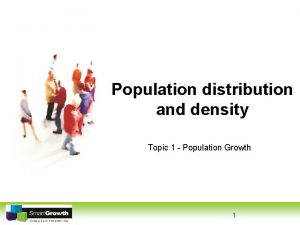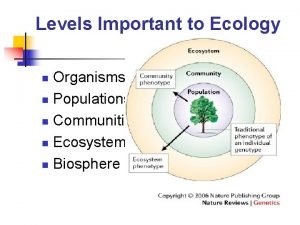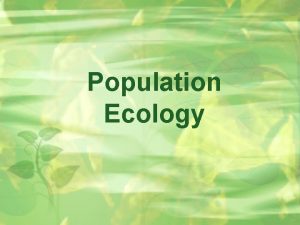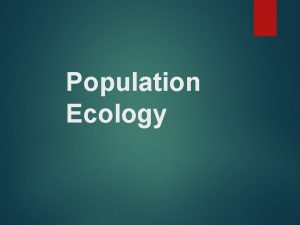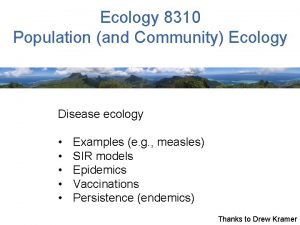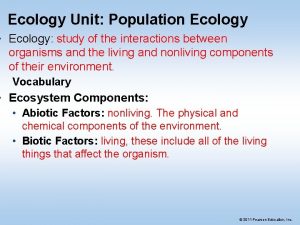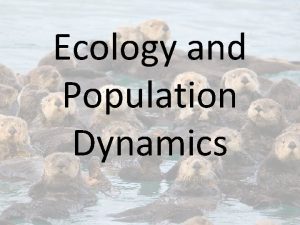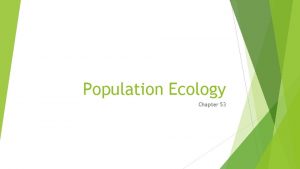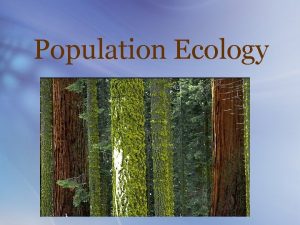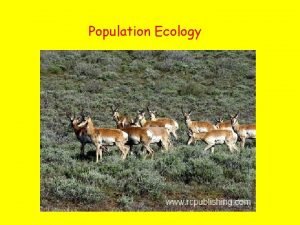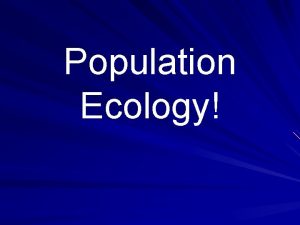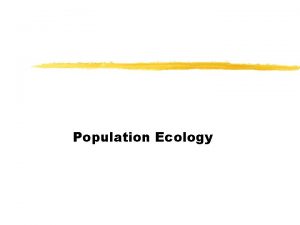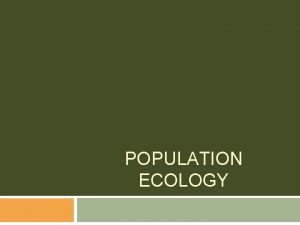Population Ecology Population Population Def the individuals of
























- Slides: 24

Population Ecology

Population • Population: • Def: the individuals of a species that live together in an area • Ex: • The red squirrels in the Field of Dreams • The dandelions in my backyard

Population Density • Population density: • Def: The size of a population that occupies a particular area. • ex: There are 210 crickets /m 2 • (210 crickets in one square meter) • A HIGH population density would mean that there are many organisms in one particular area (i. e. more crowded). • A LOW population density would mean that there are fewer organisms in one particular area (i. e. less crowded).

Population Density by State

Population Density of NH

How is Population Density Affected? • Limiting factors of the environment will affect how many organisms can live in a particular area. • Limiting factors (def): abiotic and biotic factors of the environment that will impact, or limit how many organisms can live in a particular habitat. • Examples: • Amount of sunlight • Soil • Living space • Number of potential mates • Nesting sites • What would happen if there were too many trees in the ground in one area?

Carrying Capacity • Carrying capacity (def): the largest number of organisms of one species that an ecosystem can support over time. • If the population is over the carrying capacity, some organisms will not have enough resources, and may be forced to move elsewhere, or die. • Carrying capacity is determined by the limiting factors of the environment. • What might you expect to happen to the geese population if there were more food and shelter than what was needed?

Population Changes • Populations can change because of: • Birth Rates and Death Rates • When birth rate is higher than death rate, the population will INCREASE. • When death rate is higher than birth rate, the population will DECREASE. • Moving around / Migration • Why might organisms migrate?

Factors Limiting Growth Rate • Declining birth rate or increasing death rate are caused by several factors including: • Limited food supply / competition • The buildup of toxic wastes • Increased disease • Predation

How Do Populations Grow? • Idealized models describe two kinds of population growth: 1. Exponential Growth 2. Logistic Growth

Population Changes • When resources are unlimited, populations exhibit (a) exponential growth, shown in a J-shaped curve. When resources are limited, populations exhibit (b) logistic growth. In logistic growth, population expansion decreases as resources become scarce, and it levels off when the carrying capacity of the environment is reached. The logistic growth curve is S-shaped.

Exponential Growth Curve Figure 35. 3 A

Exponential Growth Curve

Logistic Growth Curve

Logistic Growth Curve

Human Population Growth • J curve growth- EXPONENTIAL • Grows at a rate of about 80 million yearly • r =1. 3% • Why doesn’t environmental resistance take effect? • Altering their environment • Technological advances • The cultural revolution • The agricultural revolution • The industrial-medical revolution

The Human Population • Doubled three times in the last three centuries • About 6. 1 billion and may reach 9. 3 billion by the year 2050 • Improved health and technology have lowered death rates

History of the Human Population When resources are unlimited, populations exhibit (a) exponential growth, shown in a J -shaped curve. When resources are limited, populations exhibit (b) logistic growth. In logistic growth, population expansion decreases as resources become scarce, and it levels off when the carrying capacity of the environment is reached. The logistic growth curve is Sshaped.

Measuring the Size of a Population • Because it is tricky to physically count every organism in an area, ecologists use different methods to determine the population in an area. • 2 common methods are: • Sampling • Catch and release

Sampling (Quadrat Sampling) • Separate an area into equal parts. • This quadrat is 10 by 10, or 100 units 2 • Count the organisms in one square. • There may be 3 plants in one square. • Multiply by how many squares you have. • The population would be estimated at 300 plants in this 100 unit 2 area. • Find the average of the trials to estimate the population in the entire area. • Do this a few times. • Another square may have 1 plant, another may have 5.

Mark and Recapture • Commonly used with animals. • Animals are captured and marked- often with a tag of some sort. • Animals are let go, and recaptured again. • Math is used to estimate the population size. • Population size = (number initially marked) x (total recaptured) / (marked recaptured) • N = (M x T )/ R

Mark and Recapture • For example, suppose you took 200 mice out of a forest having an unknown number of mice, put leg bands on them, return them to the forest and let them mix thoroughly. • If you then take 250 mice from the forest and find 50 of them to be have leg bands, then • M = 200, T = 250, R = 50, and the unknown total number of mice (N) could be estimated as: • N = (Mx. T)/R = (200)(250)/50 = 1000 mice

Mark and Recapture • A pest control technician captures and applies ear tags to 23 brown rats, which he then releases. A week later he traps 29 brown rats, 11 of which have ear tags. What is the estimate of the total population of brown rats?

• 4 step process 1. Write the formula 2. Plug in the values 3. Solve the parentheses ONLY 4. Solve with a calculator UNITS ALWAYS!!! •
 Population def ecology
Population def ecology Chapter 4 section 1 population dynamics study guide
Chapter 4 section 1 population dynamics study guide Chapter 4 section 1 population dynamics answer key
Chapter 4 section 1 population dynamics answer key Population ecology section 1 population dynamics answer key
Population ecology section 1 population dynamics answer key Population ecology section 1 population dynamics
Population ecology section 1 population dynamics Population ecology
Population ecology Equilibrial life history
Equilibrial life history Population characteristics ecology
Population characteristics ecology Population vs community ecology
Population vs community ecology Population ecology
Population ecology Ecology
Ecology Logistic growth ecology definition
Logistic growth ecology definition What is population ecology
What is population ecology Concept 3 population ecology
Concept 3 population ecology Chapter 53 population ecology
Chapter 53 population ecology Chapter 53 population ecology
Chapter 53 population ecology The concept of population
The concept of population Population definition ecology
Population definition ecology Chapter 53 population ecology
Chapter 53 population ecology Chapter 4 population ecology answer key
Chapter 4 population ecology answer key What is uniform dispersion
What is uniform dispersion Ecology
Ecology Khi nào hổ mẹ dạy hổ con săn mồi
Khi nào hổ mẹ dạy hổ con săn mồi Thiếu nhi thế giới liên hoan
Thiếu nhi thế giới liên hoan điện thế nghỉ
điện thế nghỉ





